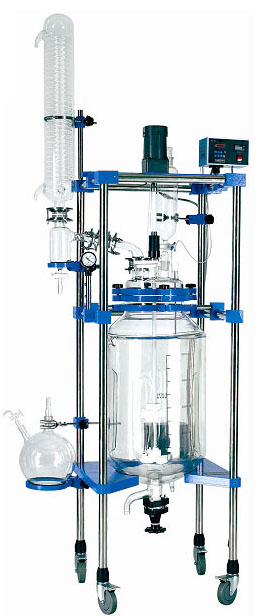HCS Glass Reactor System
Our glass reactor is manufactured from borosilicate 3.3 glass tubing. Complemented with other highly corrosion-resistant materials such as PTFE and Viton. HCS Glass Reactor Series has a high durability over a long period of time.
Borosilicate Glass is widely used for laboratory glassware. It has excellent thermal properties with its low coefficient of expansion and high softening point. It also offers a high level of resistance from water, acids, salt solutions, organic solvents and halogens.
 Application of Glass Reactor
Application of Glass Reactor
- Vacuum Distillation
- Multi-component reactions
- Gas introduction into liquid phase
- Extraction of multi-phase mixture
- Crystallization
- Reflux
- Multiple chemical reactions liquid/liquid, liquid/solid
- Low temperature chemistry
- Cell Culture
Advantages of Borosilicate 3.3 Glass Tubing
- Wide operation temperature range
- High heat resistance
- Very low thermal expansion (linear over a wide temperature range)
- Hydrophobic characteristic makes cleaning easier
- Against chemical aggressions
- Non-flammable
- High optical translucency
Properties of Borosilicate 3.3 Glass Tubing
Physical Properties
- Coefficient of Expansion (20-300oC) = 3.3 x 10-6K-1
- Density = 2.23g/cm3
- Dielectric Constant (1MHz, 20oC) = 4.6
- Specific Heat (20oC) = 750J/kgoC
- Thermal Conductivity (20oC) = 1.14W/moC
- Poisson’s Ratio (25-400oC) = 0.2
Chemical Composition
| Silicon Dioxide | SiO2 = 80.6% | Boron Trioxide | B2O3 = 13.0% | Sodium Oxide | Na2O = 4.0% | Aluminum Oxide (Alumina) | Al2O3 = 2.3% |
Thermal Properties
- 150oC – When working above this temperature, care should be taken to heat and cool borosilicate glass in a slow and constant manner.
- 500oC – Maximum working temperature
- 510oC – Thermal stress temperature
- 565oC – Annealing temperature
- 820oC – Softening point
- 1252oC – Melting point
Optical Properties
- Refractive Index (Sodium D Line) = 1.474
- Visible Light Transmission, 2mm Thickness = 92%
- Visible Light Transmission, 5mm Thickness = 91%
Standardization
ISO 3585:1991 – Glass plant, pipeline and fittings: Specification for properties of borosilicate glass 3.3
ISO 3586:1976 – Glass plant, pipeline and fittings: General rules for testing, handling and use ISO 3587:1976 – Glass plant, pipeline and fittings: Pipeline and fittings of nominal bore 15 to 150 mm
ISO 4704:1978 – Glass plant, pipeline and fittings: Glass plant components/ spare parts
HG/T2435-1993 – Fiberglass pipe and fittings
HG/T2436-1993 – Pressure testing method for glass pipelines and units
HG/T3116 – Glass plant, pipeline and fittings – General rules for testing, handling and use
GB6580 – Glass: Resistance to attack by a boiling aqueous solution of mixed alkali- Method of test and classification
GB6582 – Glass: Hydrolytic resistance of glass grains at 98 centigrade– Method of test and classification
GB12416.2 – The experimentation method and classification for Water-Resistant Particles at 121°C
If you are seeking for a reactor system, do send in your inquiries to us
